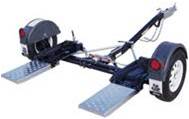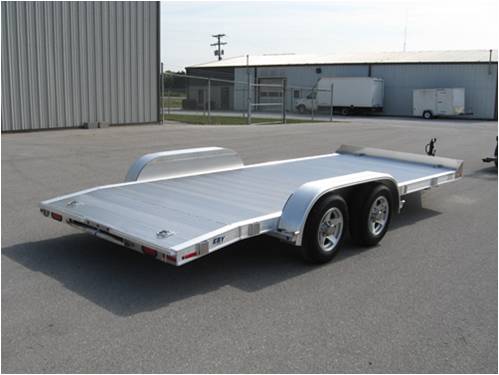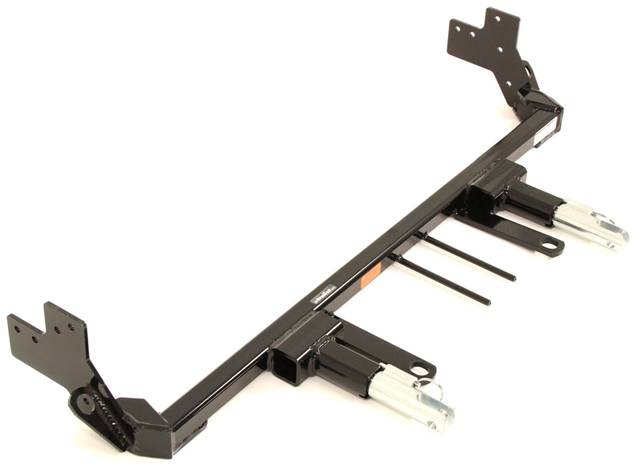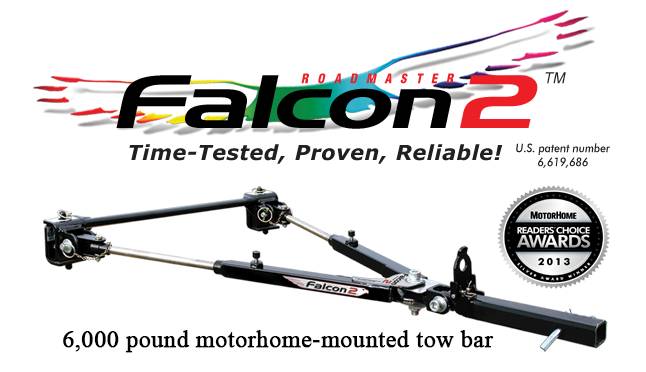Most motorized RV owners end up towing a vehicle. This goes for almost all motorized RV’s with the possible exception of the Class B van conversions. This vehicle becomes the “Toad”, a beloved term for it. A lot of planning must go into towing a vehicle. Will you want to tow it with all 4 wheels on the ground? Are you more comfortable towing a trailer with the car in it? How about a 2 wheeled tow dolly? Whatever method we choose, it is all about having a source of transportation available for touring and shopping while our motorhome is set up at a campsite.
We must be concerned with the Motorhome’s capability to tow the weight of the vehicle and trailer if so equipped. Each rig has a gross combined weight rating (GCWR) which includes the weight of both rig and towed vehicle. Under no circumstances should this ever be exceeded. The installed hitch on the motorhome also has a weight rating as to how much weight can be pulled.
No matter the towing method, a way of slowing and stopping the towed vehicle. A motorhome is designed with brakes capable of stopping with a full load up to the gross vehicle weight rating (GVWR). With the weight of a vehicle in tow, possibly with the added weight of a dolly or trailer, will add distance to the vehicle stop when the service brakes are applied. Stopping a 10 of 15 ton vehicle is hard enough without adding another several tons pushing from behind. For this reason, many states have laws requiring auxiliary braking systems installed in the towed vehicle, or the dolly or trailer.
I can’t emphasize enough the importance of having such a system on your tow. At the end of the day, all this means we have to be concerned with both towing the weight and then stopping it.
Tow Dolly
A two wheeled towing dolly is an excellent way to tow a front wheel drive vehicle with the front wheels secured to the dolly and the rear wheels on the ground turning. A new Towing Dolly will cost between $1200 and $2500 dollars. Some may have integrated braking systems that are either electrically actuated or inertia actuated also called surge braking. You will not be able to back up your rig when the loaded dolly is attached. If you do, dolly tire damage is a real probability. Without the car attached, the dolly can be backed like any 2 wheeled trailer. You will need to find a place in your campsite for the empty dolly.

Trailer
Towing an unmodified vehicle with rear wheel drive may require either an open or closed trailer with at least 2 axles. This type trailer usually comes with electric brakes installed. Such trailers can cost $2,500 and up. Enclosed trailers capable of hauling a vehicle will cost considerably more. A vehicle on or in a trailer may be backed up normally. A major safety consideration with a trailer will be the maximum tongue weight rating of the motorhome’s hitch as well as the maximum towing weight rating. Besides the added weight, another downside of any trailer is where to park it. Most RV parks do not have room to park it on site.

Towing a Vehicle 4 Wheels Down
Towing “4 down” is a very popular way of towing a vehicle behind a motorhome. Unfortunately, very few vehicles can be towed 4 down without some sort of modification. The best list I have found is from Motorhome Magazine http://www.motorhome.com/download-dinghy-guides/ . They have listings going back to the year 2000. The best source of information on whether a vehicle can be towed 4 down is from the manufacturer. Even the ones that can be towed may have certain restrictions as to speed or time as well as fuses that must be pulled. A great after market product is a wired switch placed in the fuse wiring. Here is a link to a source for these. http://www.rv-partsplus.com/rving-fuseswitch Most Standard shift transmission vehicles can be towed 4 down, but again, the manufacturer is the final authority. Otherwise you risk voiding the vehicle warranty.
As of this writing, many Jeep models, Chevrolet Malibu’s, many Ford models, and Honda CRV’s are flat towable with some restrictions. There are others as well as the now out of production Saturn line of vehicles. Fortunately, there are aftermarket modifications that can render many more vehicles towable. Chief among these is the drive line disconnect for rear wheel drive and the automatic transmission fluid pump for front wheel drive models. Made by Remco http://www.remcoindustries.com/Towing/ this equipment can be installed by many RV repair facilities.
Towing a vehicle 4 wheels down will require a special connection between vehicle and motorhome. First is the Base plate that is bolted to the frame and specific to the particular vehicle must be procured. Because they are mostly a bolt-on accessory, they can be installed by anyone familiar with basic tools. Some cutting of the plastic fascia may have to be performed to fit the base plate. The base plate contains the connection points for the tow bar.


The Tow bar completes the mechanical connection from towed vehicle and motorhome. Most will fit into the 2 inch hitch receiver on the motorhome and remain on the motorhome when disconnected. There are some models that mate up to a hitch ball and remain on the towed vehicle when not in use. There are many models of tow bars, some with integrated surge brake actuators. Make sure you choose a tow bar rated to tow the weight of your vehicle with a 20 percent safety margin. It is also wise to get a base plate made by the manufacturer of the tow bar so they will be compatible. The two major tow bar manufacturers are Blue OX and Roadmaster.
http://roadmasterinc.com/index.php
When you are towing a vehicle, auxiliary lighting of some sort is required so the tail lights of the towed vehicle will signal turns and stops as well as be lit at night. Both tow bar manufacturers make lighting systems with all the wire, lamp sockets, and socket and umbilical cable to connect to the motorhome. There are also magnetic lights that stick to the rear fenders and are either connected by a cable to the motorhome lights, or wireless models.
As with using a trailer, towing a vehicle will likely require some sort of auxiliary braking system. There are many different types on the market. Many have a unit sitting on the floor under the steering wheel and connected to the brake pedal. There can be actuated by brake light signal or by accelerometers in the system. Another very popular system is made by SMI http://www.smibrake.com/index.html that fits completely under the hood of the towed vehicle. These are available for motorhomes with both air brakes and hydraulic brakes.
Every auxiliary brake system I have found has either an available or included emergence breakaway switch. It is absolutely imperative that you install this vital safeguard. If the tow bar or other part fails, the switch will be actuated and the towed vehicle’s brakes will be actuated. You don’t want your toad to pass you!
Auxiliary braking systems require 12 volts from the towed vehicle. The vehicle’s ignition switch must be in the “Aux” position so that the steering is unlocked. Anything activated in the Aux position will be a drain on the battery. Many folks find a dead battery after a day of towing. Many people recommend a charging line between the battery of the motorhome and the towed vehicle battery. I have found a better solution from Isl Products called the Toad Charge. http://www.lslproducts.net/ToadChargePage.html It provides a fused charge controller under the toad’s hood connected to the motor home battery. It is safe and trouble free. I have been using one for 10 years.
As you can see, there is a lot to getting a vehicle ready for flat towing, but you only do it once. We have been flat towing a 2003 Hyundai Santa Fe since we started full-timing. It has a transmission lube pump to make it towable and we have had no trouble with towing it over 60,000 miles.
